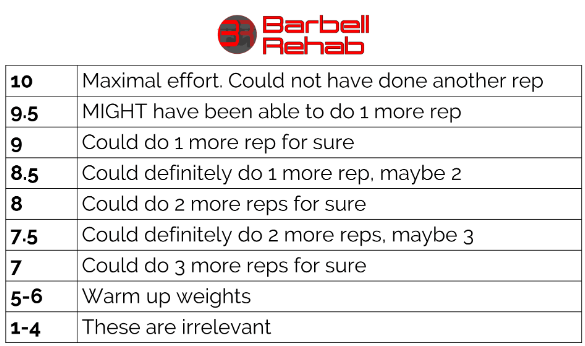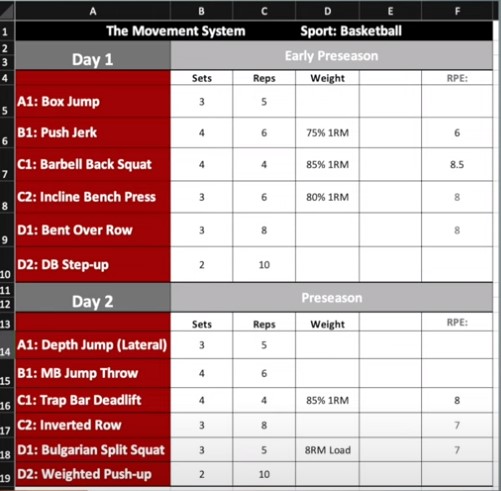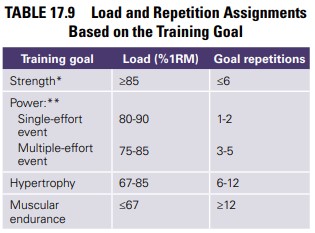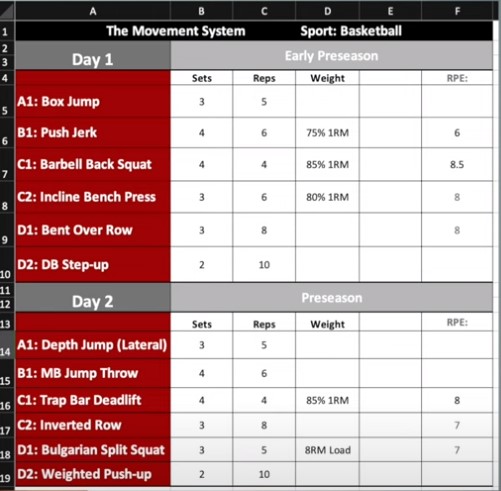CSCS Program Design | How to Write a Strength/Power Program using %1RM vs. RPE
Jan 23, 2023
Edited by: Danielle Abel
CSCS Program Design for Strength and Power
Program Design is one of the most challenging sections of the NSCA CSCS Exam. So, in this article, we're going to dive deep into programming with RPE and % of 1RM. You can also watch the video below for a full in-depth discussion.
First, in order to understand programming for strength and power, you first need to know what RPE is.
Rating of Perceived Exertion (RPE)
RPE stands for Rating of Perceived Exertion and is used to quantify the intensity of a resistance training program.
The RPE rating scale is from 1-10. Here's a nice chart from the Barbell Rehab blog.

This chart might help you to quantify how many reps you have left in the tank. Typically warm-up sets should be between an RPE 5-6, whereas working settings are anywhere from RPE 6 to RPE 9, depending on the week of training inside of a given training block using progressive overload.
Why RPE?
You might be wondering, why wouldn't you just program based on a % of 1RM for a given movement? Or, possibly, you're wondering when to use RPE over 1RM.
RPE allows for auto-regulation, which is simply a fancy term that shows that it allows the lifter to modify the load within each training session based on their level of readiness and fatigue. Prescribing load with 1RM doesn't allow the lifter to auto-select the level of intensity that feels best for them that session.
An even simpler way of explaining RPE is using internal and external feedback. Internal load relates to what the lifter is experiencing during the training session, essentially how they feel. Whereas the external load is the weight on the bar, essentially how much resistance they are applying to their body.
For example, 225lbs could be
- Significantly more than Person A could lift
- Significantly less than Person B could lift
Additionally, using RPE, we can prevent added fatigue by starting at a lower RPE at the beginning of a new strength block and gradually working our way up to a higher RPE at the end of the block.
RPE helps integrate internal and external load, vs. with % based loading only; the internal load isn't necessarily accounted for.
Reps In Reserve (RIR)
Reps in reserve is another way to quantity internal and external training load but works opposite of RPE. Reps in reserve simply refers to the number of reps you had remaining in the tank.
If we think of an RPE 7, this equates to about 3 RIR. RPE 8 is about equal to 2 RIR, and RPE 9 is about equal to 1 RIR.
Who should use RPE or RIR?
According to Helms, Cronin, Storey, & Zourdos (2016), RPE and RIR are best used with more advanced lifters because they are more accurate in their assessment of RIR or RPE. The authors also indicated that the ability to perform maximally loaded movements at slow speeds was indicative of an advanced lifter.
Who should use % of 1RM?
Again according to Helms, Cronin, Storey, & Zourdos (2016), beginner lifters may do better with prescribed % of 1RM as they aren't as accurate with their ability to gauge how close or far away they are from failure.
If you're looking for a system to learn how to write great strength & conditioning programs, complete with in-depth explanations, templates, and examples, and is approved for NSCA CEUs to maintain your CSCS, you might want to check out our Program Design 101 Course here.
Programming Strength with % of 1RM and RPE
It might be helpful to think about programming with both % of 1RM and with RPE so that you can see the correlation between the two types of intensity logic. However, you're typically going to choose one and go with it.
Here's an example of a strength & power program for a basketball athlete that includes both to help you see how they correlate to one another.

If you decide to program with % of 1RM, you could leave the RPE column blank and actually have your athlete fill out what they felt the RPE was at that % of 1RM. Conversely, you could fill out the RPE column with their RPE goals, then have the athlete fill in the weight they used to get to that level of RPE.
If we look at the Barbell Back Squat in the example above, we can see that it shows 85% of 1RM or an RPE of 8.5. The logic behind this intensity goal first started with deciding if the barbell back squat in this particular program would be treated as a strength or as a power exercise. We decided it would be treated as a Strength exercise, so we chose to load it in the strength percentage zone, so we chose 85% or RPE 8.5 RPE, because strength exercises should be loaded at 85% or greater of 1RM, according to the National Strength and Conditioning Association (NSCA)'s Load and Repetition Assignments Based on the Training Goal chart below.

(Photo Credit: National Strength and Conditioning Association)
When it comes to power, if we had chosen Power instead of Strength, then instead of loading it at 85%, we might have chosen to start it at 76% of 1RM to be within the multiple effort repetitions range of 75-85% of 1RM as seen above.
If we look at the RPE in the barbell back squat example above, we can see that an RPE equivalent of 8.5 was assigned here. If we think about the maximum number of repetitions that an athlete could do for Strength, at or above 85%, then we'll see that less than or equal to 6 reps is appropriate. Knowing that the athlete will do 4 sets of 4 repetitions, assigning an RPE of 8.5 would be appropriate because the athlete will want to leave 1-2 reps in the tank. If an RPE 8 is equivalent to leaving 2 reps in the tank and an RPE 9 is equivalent to leaving 1 rep in the tank, then an RPE 8.5 is right in the middle.
The biggest thing to keep in mind here is that there is no perfect way to do it, but what might be helpful is to think about the skill level of your client. If they're a beginner, you might want to start by assigning a % of their 1RM. However, if you're working with an intermediate to advanced athlete, then you might choose to give them an RPE goal and allow them to assign the load.
Assigning Intensity for Accessories
In this example, you can see we assigned RPE for some of the multijoint accessories like rows, but we didn't assign intensity for the others. It's completely up to you how you want to program accessories. Accessories will not be as fatiguing on the central nervous system because often they are single-jointed movements. However, if you are using multi-joint accessories as accessories by programming them in hypertrophy (6-12) or muscular endurance (12-15+) ranges, then assigning an RPE might be helpful to manage fatigue.
Programming Power with % of 1RM and RPE
If we take a look at this program again and this time instead look at the push-jerk movement, you might be able to now see that the movement is more power based in regards to the programming logic. Based on what you learned above, you'll probably see that the % of 1RM loading starts at 75%.

When we look at the RPE assignment here, we want to be mindful that the athlete is not loading the bar too heavily and treating it like a strength movement, so this is why we chose an RPE 6. You could also choose an RPE 7 or a 7.5, but we really want Power here with higher bar speeds.
So it may be helpful to communicate to clients your programming intent, so they don't mistakenly load the movement too heavily.
Other Components of Program Design
With this program, we tried to select movements that were similar to movements found in basketball. For example, the med ball jump throw would be very similar to passing a ball in basketball. Even more so, if we look at the trap bar deadlift and think about the position that the athlete would be in, it's very similar to how a shot in basketball would occur where the athlete would be crouched down and then exploding upwards with an upright torso.
With the example of the trap bar deadlift, we want to be maximizing both strength and power, so at the beginning of the program; we might start loading it at 85% and then, as the training block goes on, reduce the % of loading for example to 82%, 80%, and then 78%, and really allowing the athlete to move with a high rate of bar speed.
Lastly, if we look at the Bulgarian Split Squat, we'll see that the intensity is programmed with an 8RM load. Using an 8RM load simply means that the athlete would only do 5 reps, but they would load it at what they could do for 8 reps. If we want to take it a step further, we would know that doing 5 reps for what they could do for 8 would mean that they leave about 3 reps left in the tank or about an RPE 7.
If you found this article helpful, then you would probably find our Program Design 101 Course even more helpful.
Support & Courses Available
Ready for even more support? Our Program Design 101 Course teaches you exactly how to organize an annual training plan and provides sport-specific examples, and even includes done for you programming templates by phase. Click the link here to check it out.
Stay connected with news and updates!
Join our mailing list to receive the latest news and updates from our team.
Don't worry, your information will not be shared.
We hate SPAM. We will never sell your information, for any reason.

